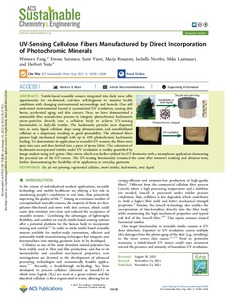UV-Sensing Cellulose Fibers Manufactured by Direct Incorporation of Photochromic Minerals
Fang Wenwen; Lastusaari Mika; Norrbo Isabella; Rissanen Marja; Sairanen Emma; Sixta Herbert; Vuori Sami
https://urn.fi/URN:NBN:fi-fe2022012710850
Tiivistelmä
Textile-based wearable sensors integrated into daily wear offer opportunities for on-demand, real-time self-diagnosis to monitor health conditions with changing environmental surroundings and hazards. One still underrated environmental hazard is accumulated UV irradiation, causing skin burns, accelerated aging, and skin cancers. Here, we have demonstrated a sustainable fiber manufacture process to integrate photochromic hackmanite micro-particles directly into a cellulose body to achieve UV-sensing functionality in daily-life textiles. The hackmanite particles were dispersed into an ionic liquid cellulose dope using ultrasonication and nanofibrillated cellulose as a dispersant, resulting in good spinnability. The obtained fibers possess high mechanical strength with up to 10% photochromic hackmanite loading. To demonstrate its application in wearable UV sensors, the fibers were spun into yarn and then knitted into a piece of jersey fabric. The coloration of hackmanite-incorporated textiles under UV irradiation is readily quantified by image analysis using red–green–blue ratios, which was further utilized for UV dosimetry with a smartphone application showcasing the practical use of the UV sensor. The UV-sensing functionality remained the same after intensive washing and abrasion tests, further demonstrating the feasibility of its application in everyday garments.
Kokoelmat
- Rinnakkaistallenteet [19207]
